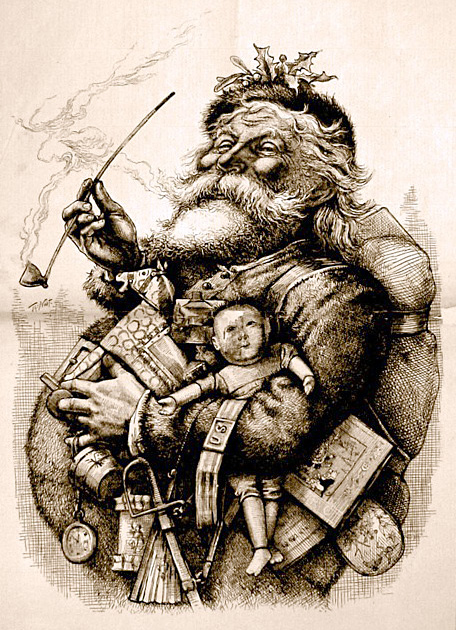
1,800 miles per second. 14.3 quintillion joules of energy per second. 214,200 reindeer. These are the numbers from typical treatments of the science of Christmas. You know the sort of thing — make some assumptions and estimates about the number of (Christian? Western? Christmas-observant?) children in the world, where they live, how much their presents weigh, etc., plug it all into a model, solve for the unknowns, and you’ve got a sort of reductio ad absurdum argument against the existence of Santa Claus. So imagine my surprise when, while going over all this evidence, I had a bit of a conversion experience.
It turns out that I believe in Santa Claus.
Now, to be clear, I don’t actually believe in a solitary individual who resides at the North Pole and oversees a colony of toy-making elves. For one, the logistics do seem to strain plausibility (although we could always postulate additional dimensions of space and/or time to make the problem tractable). More to the point, there is 1-to-1 correspondence between gifts under the tree and gifts purchased by local agents (relatives, friends, etc.), leaving little room for the participation of a third party.
And yet, empirically we cannot deny the reality that millions of presents are delivered nearly simultaneously Christmas morning in the name of Santa Claus. How are we to explain this observation?
We can invoke Coca-Cola ads and big Eastern syndicates, claiming that we have been duped into perpetuating the Santa myth so that retailers can make a buck. But the facts don’t support a purely corporate origin. And if there is a conspiracy, we are surely informed and aware participants. Charlie Brown has been decrying the commercialization of Christmas since 1965; we can hardly claim naïveté 50 years later.
Even if they aren’t all cynically commercial, we can still deconstruct various ingredients that contribute to the modern mythos of Santa — assorted Germanic and Scandinavian stories, the Victorian invention of childhood, etc. — and declare the matter settled (just as we might deconstruct Christmas itself as merely a hodgepodge of Saturnalia and German pagan festivals). But this just separates the core concepts from the inessential “just-so” details that happen to accrete along the way.
We might dismiss Santa as an exercise in nostalgia — an attempt to reproduce for our children the Christmas experience we had (or perhaps wished we had). But that doesn’t really explain why Santa was so widely adopted in the first place. Somewhere along the line, people told their children about Santa Claus without having fond memories of believing in Santa themselves. It would seem like Santa must serve some tangible purpose in order to explain the powerful hold the concept has on our psyches, to mobilize us to distribute all those gifts on his behalf.
So, what might that purpose be?
Perhaps Santa serves as an exemplar of mercy. He supposedly separates the naughty from the nice, allowing us to threaten lumps of coal on anyone leaning toward the naughty label. And yet, even though all children misbehave, when the appointed morning arrives there’s nary a speck of anthracite or bituminous to be found. Santa can afford to be merciful, allowing parents to be agents of justice without appearing inconsistent or capricious.
Similarly, Santa demonstrates the idea of unmerited favor. There is an expectation that parents are supposed to give good things to their children as they are able, whether those are daily blessings of hearth and home, or gifts for birthdays or other special events. Gifts from grandparents, siblings, and even friends may likewise be attributed to familial or social obligation, or reciprocity. But Santa gives gifts to kids because, well, because that’s what he does. He’s the embodiment of giving for its own sake.

And why would we need to invent someone to exhibit these characteristics, when real life individuals are merciful and bestow unmerited favor? I suspect there might be something beneficial to the universality of Santa; he provides a common point of reference that allows for broader conversations. In fact, one could formulate an emergent theory of Santa, hypothesizing that as a society becomes more interconnected, a need arises for a shared narrative. That shared narrative likely evolves as a homogenization of accounts of specific real people. We can even point to the actual Saint Nicholas as one such real person whose contributions are still recognizable.
But what about Jesus? As Christians, shouldn’t we insist that Jesus alone be our standard for mercy and unmerited favor? While I certainly would not advocate a Christmas focused solely on Santa, I think he can have value even for Christians. Thinking back to where we started, with the reindeer traveling near light speed — why do scientists build models of things like Santa’s gift-giving trips (or the climate of Middle Earth) and then experiment (read: play) with them? For that matter, why do we give our children toy cars and dolls? These models, these simplified versions of reality, allow us to engage with certain ideas in a more readily digestible way. And they allow for a low-stakes engagement, where mistakes or misunderstandings have minimal consequences but still provide valuable learning experiences.
In this way Santa can model certain aspects of Jesus for children, in a form that is easier for them to comprehend. It also alleviates a need to simplify Jesus himself for children and introduce the possibility that they will conflate the toy version and the real one.
Now, that doesn’t mean that we need to embrace every depiction of Santa Claus uncritically. Plenty of things have been done in his name that are not consistent with what I am proposing is valuable about him, just as plenty of things are done in Jesus’ name that he would scarcely recognize let alone endorse. But I do think that Santa is a useful fellow to have around, and is a valid phenomenological explanation for how those presents get under the tree.
Andy has worn many hats in his life. He knows this is a dreadfully clichéd notion, but since it is also literally true he uses it anyway. Among his current metaphorical hats: husband of one wife, father of two teenagers, reader of science fiction and science fact, enthusiast of contemporary symphonic music, and chief science officer. Previous metaphorical hats include: comp bio postdoc, molecular biology grad student, InterVarsity chapter president (that one came with a literal hat), music store clerk, house painter, and mosquito trapper. Among his more unique literal hats: British bobby, captain’s hats (of varying levels of authenticity) of several specific vessels, a deerstalker from 221B Baker St, and a railroad engineer’s cap. His monthly Science in Review is drawn from his weekly Science Corner posts — Wednesdays, 8am (Eastern) on the Emerging Scholars Network Blog. His book Faith across the Multiverse is available from Hendrickson.

Leave a Reply